Some more exploring around Melbourne - to start, back around Ringwood where my friends live, this time following the same trail but in a different direction, over to Ringwood Lake and surrounding park. Ringwood Lake Park is a 8.5 hectare park with a little, man-made lake that has just over a kilometre of walking trail around it.
Some very noisy cockatoos kept me company while I was walking.
Unlike at home, as you can see there’s nothing other than a sign to alert walkers to the train tracks - no barricade or anything. You can, quite literally, walk out onto and along the tracks if you’d like. And yes, this is a very active commuter train line.
Back into Melbourne again, and this time I wanted to explore a part of the city that was only just beginning to be developed the last time I was there - an area known as Docklands.
Before the foundation of Melbourne, what is now Docklands was a large wetlands area of the Yarra estuary consisting of a large salt water lagoon and a giant swamp. During the early to mid 20th century the area gradually turned from the west Melbourne swamp to slum and then to a shipping port, which at the time became Melbourne’s busiest. However, by the 1960s the docks in this area became inadequate for the new container ships, effectively rendering redundant a vast amount of vacant inner-city land to the immediate west of Melbourne’s CBD.
When I made my first trip to Melbourne, in the 1990s, Docklands was notable for its underground rave dance scene. In 2000, urban renewal began in earnest with the apartment boom, and as it became a sought-after addresses several independent and privately owned businesses as well as national corporations moved their headquarters here. Although now a location with some very contemporary architecture the area has also been highly criticized for its lack of transport and ‘wind tunnel’ effect, lack of green spaces and community facilities…and is currently being labelled as a ghost town due to rapidly declining activity, especially now, post-COVID. Although I certainly enjoyed walking around here for the day it was definitely not a busy place, especially given that it has a lovely, waterfront esplanade.
The low-rise brown building on the right is a public library. Nice place to sit, relax and read!
One really neat thing about Docklands was the public art!! I’ve heard there’s about 70 pieces in the area of which I only saw a smattering today - and here’s a few.
“Shadow Trees” by Sally Smart
“Toy Rabbit” by Emily Floyd
“Continuum” by Michael Snape
“Aurora” by Geoffrey Bartlett
“Whitecaps” by Ari Purhonen
My absolute favourite, “Cow up a tree” by John Kelly
“Silence” by Adrian Mauriks
Native black swans can still be seen calling Docklands home.
Loved these buildings!!
“Monument Park” by Callum Morton
The Melbourne Star is a 120 metre tall ferris wheel in Docklands. It opened in 2008 but closed 40 days later due to structural defects and unfortunately repeated delays in reconstruction meant that it did not reopen again until December 2013. Due to COVID the wheel closed again, this time permanently, in 2021 and now it remains in situ, but still non-operational.
Established in the 1850s during the Victorian gold rush, Chinatown in Melbourne is notable for being the longest continuous ethnic Chinese settlement in the Western World and the oldest Chinatown in the Southern Hemisphere.
Cohen Place
The Sum Kum Lee building, built in 1887
The first Melbourne Post Office was erected on this site in 1841. The present building was erected 1859-1867.

































No comments:
Post a Comment